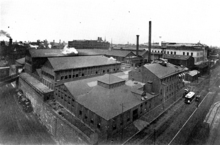William Sellers
| William Sellers | |
|---|---|
 | |
| Born | September 19, 1824 |
| Died | January 24, 1905 |
| Residence | "Clifton" Bellefonte, Delaware[1] |
| Known for | proposing United States standard system of screws, threads, and nuts |
| Spouse(s) |
Mary Ferris Amélie Haaszm |
| Signature | |
 | |
William Sellers (September 19, 1824 – January 24, 1905) was a mechanical engineer, manufacturer, businessperson, and inventor who filed more than 90 patents, most notably the design for the United States standard screw thread. As president of the Franklin Institute in Philadelphia, Pennsylvania, Sellers proposed the adoption of a system of screw threads which was easier for ordinary mechanics and machinists to cut than a similar design by Joseph Whitworth. For many years, he led the machine tool firm of William Sellers & Co., which was a very influential machine tool builder during the latter half of the 19th century.
Family
Sellers was born in Upper Darby, Pennsylvania to John and Elizabeth (Poole) Sellers, into a Quaker family full of industrial and manufacturing innovators.[2] His cousins include George Escol Sellers (1808–1899), an inventor holding patents for a hill-climbing locomotive, a pulp-paper process, converting steamboats to coal, and removing brine from salt water, and Coleman Sellers II (1827–1907), a five-term president of the Franklin Institute, who was instrumental in harnessing Niagara Falls for electricity.
Sellers was married in 1849 to Mary Ferris (1820–1870), with whom he had three children, Katherine (1852–1917), William (1856–1933), and Frances (1858–1859). He married again in 1873 to Amélie Haaszm (1842–1929), with whom he had another three children, Alexander (1875–1957), Richard (1881–1942), and Christine (1882–-1884). He died in his hometown on January 24, 1905 at the age of 81.
Career

Pennsylvania Avenue, Hamilton, 16th and 17th Streets
After receiving a private education in a family-run school, he began apprenticing at age fourteen with his uncle, J. Morton Poole, in a machine shop near Wilmington, Delaware. After seven years, he moved to Providence, Rhode Island to run the shops of what eventually became the Corliss Steam Engine Company. Returning to West Philadelphia to start his own machine company, he eventually formed a partnership with his brother-in-law Edward Bancroft (1811–1855) in 1848. After Bancroft's death in 1855, Sellers incorporated as William Sellers & Co., which continued to operate until 1947 when it was sold to the Consolidated Machine Tool Corporation and relocated to Rochester, New York.
In 1847 Sellers was elected a member of the Franklin Institute, where he served as a member of the Board of Managers from 1857 to 1861 and again from 1864 to 1892, and as president from 1864 to 1867. At a meeting on September 15, 1864, he presented a uniform system of screw threads which with its angle and its flat top and bottom differed from Whitworth's British standard. Within a few years, the system had been adopted by the government workshops, leading railroad companies, prominent machine tool builders and others, under the various names of the United States, Sellers, or Franklin Institute Systems.
Positions
- American Philosophical Society - elected member (1864)
- Franklin Institute - elected president (1864)
- University of Pennsylvania - elected trustee (1866)
- Fairmount Park - appointed member of the first commission (1868)
- Edgemoor Iron Company - elected president (1868)
- Philadelphia, Wilmington and Baltimore Railroad - elected director (1868)
- Philadelphia and Reading Railroad - director
- Centennial Exposition, Board of Finance - elected vice-president (1873)
- William Butcher Steel Works (reorganized it as Midvale Steel Company) - president (1873–87)
- National Academy of Sciences in Washington - elected member (1873)
- Société d’encouragement pour l’industrie nationale in Paris - appointed member (1875)
Awards
- Paris Exposition of 1867 - gold medal[3]
- Vienna Exposition of 1873 - Grand Diploma of Honor and five gold medals[3]
- Paris Exposition of 1889 - Grand Prix, Chevalier de la Légion d'honneur[3]
References
- ↑ Dunlap, Gertrude F. (1992). Fox Point Remembered. DIANE Publishing. p. 3. ISBN 978-0-941375-49-8. Retrieved 2008-08-29.
- ↑ Scharf, John Thomas and Thompson Westcott (1884). History of Philadelphia, 1609-1884. L. H. Everts & co. pp. 2263–2264. Retrieved 2015-01-17.
- 1 2 3 "William Sellers". Cassier's Magazine. Cassier. X: 231–233. May–Oct 1896. Retrieved 2015-01-17.
External links
- Société d’encouragement pour l’industrie nationale
- Invent Now Hall of Fame Inventor Profile for William Sellers at www.invent.org
- ASME Celebrates its 125th Anniversary: Landmarks 2005: William Sellers at the Franklin Institute at anniversary.asme.org
- Wired 10.01: Turn of the Century at www.wired.com
 "Sellers, William". New International Encyclopedia. 1905.
"Sellers, William". New International Encyclopedia. 1905.